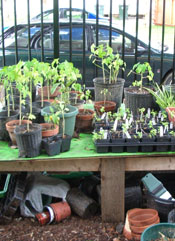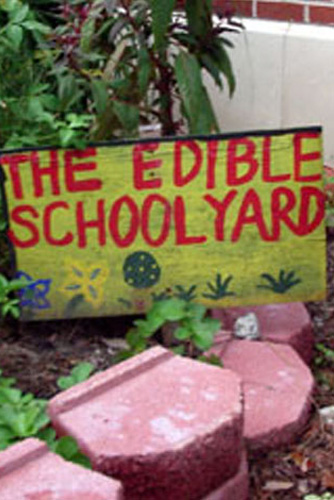Thanksgiving in the City, Part I
Thanks For a New Orleans Schoolyard and Holiday Cooking
I am back from spending most of last week in New Orleans. I hadn't visited this beloved and idiosyncratic city since Katrina and it is bleak to see the state of things now more than two years after the storm. My friends there are very active in the community and they helped me understand the practical optimism that is needed to keep going. Still, a drive through the Lower Ninth Ward was heart breaking and even the most resilient of us would find it hard to not be discouraged.
But I was buoyed by my visit to The New Orleans Edible Schoolyard at the Samuel J. Green Charter School/New Orleans Charter Middle School. Soon after Katrina, volunteer leaders in the community and the inspiring Alice Waters (who created her first Edible Schoolyard in Berkeley, California) created this program to teach children where food comes from and how it's grown and cooked. Funded 100% by private contributions, and with collaborations with the Crescent City Farmers Market, The Edible Schoolyard is a city garden, a classroom, a kitchen, a cafeteria, outreach to area farmers, and a way to change kids' lives, and maybe their parents' as well.
It's not unique to New Orleans to have city kids -- or adults, for that matter -- with no idea where their food comes from. In a sweet example, teacher Eric Kugler, a New Yorker with remarkable compassion and commitment who headed to New Orleans after Katrina to help in the recovery and stayed, told me how when it was time to harvest the end-of-summer okra, one student anticipated that jars of pickled okra would be found in the schoolyard garden. Every September a new crop of New Orleans children begins to learn about food in a program fully integrated into their school's academic curriculum. In a city beloved for its Cajun and Creole and uniquely New Orleans cooking, it is exciting to see a new food chapter being written. And it is heartening to know that this has come out of the hurricane's devastation.
A Realistic Perspective on Home Cooking
Just before heading to New Orleans I went to a book signing by Christopher Kimball at Borders Columbus Circle. He runs America's Test Kitchens and its various media -- the eponymous PBS television series, Cook's Illustrated and Cook's Country magazines, and a growing collection of cookbooks. He was in New York promoting their newest title, America's Best Lost Recipes (see our review), but spoke mostly about the general state of home cooking.
Mr. Kimball may be more knowledgeable about home cooks -- both city and country -- than any other food journalist working today. As we head into the pressure cooker known as "cooking for the holidays," a few of his observations bear repeating and remembering:
• Despite the bounty of cookbooks and food television programs, most home cooks have a small repertoire. We know what we like to eat and cook and we tend to make the same dishes repeatedly. There is nothing wrong with this. In fact, it's smart.
• Restaurant cooking has changed in America vastly more than home cooking has. With all the attention given to new restaurants and new professional chefs, it's easy to think that a competent home cook is coming up short by not always making the next new thing. That's not a fair test because what we do at home is different than in the professional kitchen.
• While restaurant cooking may be art, home cooking is science. And as with music, we must learn the rules and the basics before we can improvise. Do not be intimidated by your grandmother who effortlessly knocks off your favorite holiday dishes. Mr. Kimball rightfully said: "She's been making the same 20 dishes every week for 50 years. That's why it looks so easy."
Heading Toward Thanksgiving
Mr. Kimball's comments reminded me of the woman in Fairway who inspired me to create The City Cook. It was the week before Thanksgiving three years ago and as she stood in the produce aisle, clutching an 8 1/2 by 11-inch piece of lined paper filled by her holiday grocery list, the wall of vegetable bins was unraveling her ambition. With fear in her voice, she asked me, the nearest stranger, for help in selecting an onion from Fairway's bounty of choices. I knew how she felt.
For many of us the coming holidays are the reason we want to be confident and competent home cooks. The myth created by TV chefs, glossy cookbooks and grandmothers is that it's easy. It's not.
In the coming days I'll begin a series of articles to help you get through the cooking-intensive holidays. To get you started, here are some essentials:
- Make a plan. For the menu, the shopping, the cooking, and for the tabletop.
- Shop in advance. New Yorkers can get wacky at the holidays and things will sell out, especially turkeys, cans of puréed pumpkin and bakery-made apple pies.
- Try to stay out of food stores the day before Thanksgiving. Otherwise you may cry in public.
- Do less but make it better. Instead of making 10 different sides dishes, make three with care.
- Fancy isn't necessarily good. With superb ingredients, simple can be best.
- Continue a family tradition. Or start your own.
- It's okay to let guests help or contribute a dish, but you should stay in charge. It's your kitchen and you're the cook, meaning you know how the whole meal will come together.
- A holiday celebration doesn't have to be a big bash. A meal for two or for one can have the best taste if it's at the table where you most want to be.
First up is Thanksgiving. If you plan to do anything remotely resembling a traditional Thanksgiving dinner, I recommend that you purchase a book by the editors of Fine Cooking magazine called How to Cook a Turkey And All the Other Trimmings. See our review. I'm not prone to hyperbole but this book is really outstanding and you'll use it year-round.
Finally, enjoy this wonderful time as a city cook. Lucky us that we can invite others to sit at our table and we can cook for them. Isn't that what the holidays are all about?





